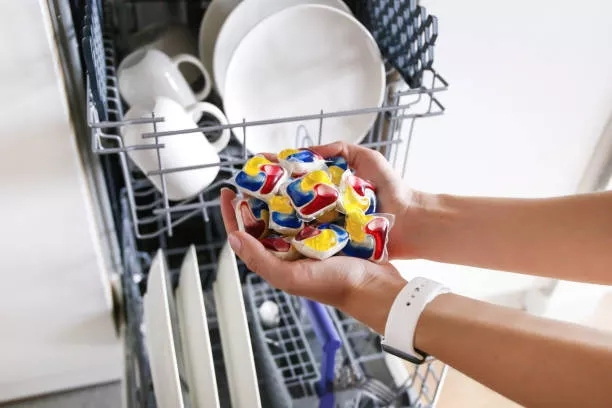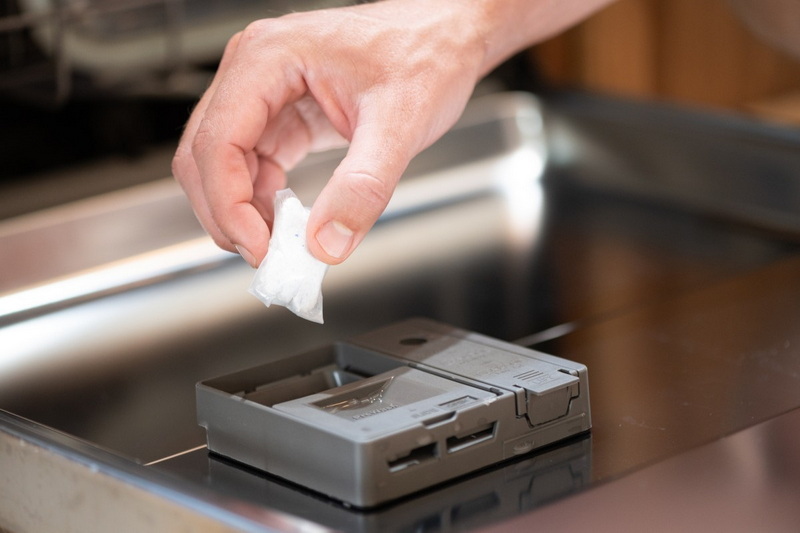Dongguan UFine Daily Chemical Co.,Ltd.
- All
- Product Name
- Product Keyword
- Product Model
- Product Summary
- Product Description
- Multi Field Search
Views: 222 Author: Tomorrow Publish Time: 11-16-2025 Origin: Site











Content Menu
● Why People Consider Changing
● Detergent Formats: Pods vs. Alternatives
● How to Decide if You Should Change
● Tips for Getting the Best Results with Pods
● Common Issues and Troubleshooting
● Maintenance and Care for Your Dishwasher
● Environmental Considerations
● Choosing a Detergent Strategy: A Step-by-Step Plan
● Advanced Considerations: Technological Trends
● FAQ
>> 1. Can dishwasher pods be used in all dishwasher models?
>> 2. Do I need to use a rinse aid with dishwasher pods?
>> 3. Are pods better for hard water or soft water?
>> 4. Will switching from pods to powder or liquid save money?
>> 5. How can I tell if my dishes aren't drying properly due to detergent?
Dishwasher pods have become a standard option for households seeking convenience and consistent cleaning performance. However, many users wonder whether switching to a different type of detergent—or changing the way pods are used—can improve results or save money. This article examines common questions about dishwasher pods, their composition, how they work, and practical tips for optimizing dishwasher performance. The goal is to provide clear guidance for choosing the right detergent format, loading strategies, and maintenance practices that keep dishes clean while protecting the appliance.
A dishwasher pod is a pre-measured gel or powder packaged in a water-soluble wrapper. Each pod contains a blend of detergent, enzymes, and sometimes rinse aid or water softeners designed to release in the wash cycle. Pods are designed to simplify dosing, reduce handling mess, and provide consistent cleaning performance across multiple loads.
- Cost per load: Pods can be more expensive per use than bulk liquid or powder detergents, depending on brand and store promotions.
- Cleaning performance: Some users find that pods work best for certain water temperatures or soil levels, while others prefer an alternative format.
- Environmental impact: Packaging and formulation differences may influence a consumer's choice based on sustainability goals.
- Compatibility: Some dishwashers or water conditions respond differently to various detergent formats.
- Convenience and waste reduction: Reusable tablets or concentrated liquids may appeal to those seeking less plastic waste.
- Pods: Pre-measured doses; convenient and low-dust; may be less flexible for heavy soils or large loads.
- Liquid detergents: Quick-dissolving; easy to adjust dosage; often more economical per load; may require measuring.
- Powder detergents: Usually economical; can be messier; may leave residue if not fully dissolved.
- Gel or tablet boosters: Some products include extra rinse aids or mineral-softening components; check for compatibility.
- Eco-friendly or concentrated formulas: Designed to reduce packaging and sometimes to minimize environmental impact.
- Evaluate water hardness: Hard water can reduce cleaning efficiency; consider a detergent formulated for hard water or adding a rinse aid.
- Assess soil and load size: Heavily soiled pots and pans may benefit from a more robust or concentrated detergent format.
- Check dishwasher compatibility: Some machines are optimized for powder or liquid detergents; read the user manual for detergent recommendations.
- Compare costs: Calculate cost per load for pods versus alternative formats, including any savings from promotions or concentrate usage.
- Consider environmental goals: If packaging or ingredients matter, research brands with recyclable packaging or cruelty-free formulations.
- Use the right cycle: Choose a cycle appropriate for the load's soil level; shorter cycles may not fully dissolve pods in some machines.
- Load correctly: Place dishes so spray arms can reach them; avoid overloading, which can hinder cleaning and cause pod ineffectiveness.
- Ensure water is flowing: Clean spray arms and filter regularly to maintain optimal cleaning performance.
- Use a compatible rinse aid: If your dishwasher requires rinse aid, use it to improve drying and prevent water spots.
- Store pods properly: Keep pods in a cool, dry place away from moisture to prevent premature dissolution or clumping.
- Pods not dissolving: Check water temperature, cycle length, and whether the pod wrapper remains intact; ensure the dispenser is dry and clean.
- Residue on dishes: Consider switching to a different format or increasing rinse aid; also check water hardness and incoming water temperature.
- Poor drying: Ensure the rinse aid is used if recommended; run a hot rinse or use an "extra dry" option if available.
- Dishwasher error codes: Some detergents can interfere with sensors or clog dispensers; if problems persist, try a different format and consult the manual.
- Packaging waste: If sustainability is important, look for compact or refillable options and brands with minimal packaging.
- Clean filters regularly: A clogged filter reduces cleaning efficiency and may necessitate higher detergent use.
- Run occasional cleaning cycles: Use a dishwasher cleaner to remove grease and detergent buildup.
- Check seals and gaskets: Damaged seals can affect performance and may require a different detergent approach if you notice leakage.
- Use the right amount of detergent: Even with pods, overly full detergent chambers or incompatible cycles can cause residue or poor cleaning.
- Monitor water quality: If your area has particularly hard water, you might need a water softener or a detergent formulated for hard water.

- Packaging: Pods typically come in plastic or film pouches; some brands offer recyclable or compostable packaging.
- Ingredients: Some regions require certain disclosure standards; look for certifications or third-party testing if this matters.
- Waste reduction: Many consumers reduce waste by using concentrated liquids or tablet refills, or by choosing brands with refill options.
- Small households with soft water: Pods may provide straightforward, effective cleaning with minimal mess and consistent dosing.
- Large families with mixed loads: A bulk liquid or powder detergent could be more economical for high-volume use, especially if combined with a high-capacity machine.
- Eco-conscious shoppers: Compare packaging, ingredients, and production practices; select brands with transparent sustainability policies.
- Tech-heavy kitchens: If a smart dishwasher has built-in detergent suggestions, follow manufacturer recommendations and test a supported detergent format for best results.
1. Determine your priorities: Cost, convenience, environmental impact, or cleaning performance.
2. Test a couple formats: Use pods for a month, then switch to a bulk detergent for another month to compare results.
3. Track results: Note cleanliness, drying quality, and any residue or odors; consider water hardness tests.
4. Evaluate total cost: Include purchases, promotions, and potential replacements for damaged cycles.
5. Decide and standardize: Pick a format that consistently meets your criteria and stick with it to maintain appliance behavior.
- Sensor-driven dosing: Some high-end dishwashers adjust parameters based on soil sensors; these may interact differently with dense or thick formulations.
- Enzyme-enabled detergents: Enzymes can break down complex proteins and starches at lower temperatures, potentially saving energy; verify compatibility with your appliance.
- Eco-labeling: Certifications such as Ecolabel or equivalent regional standards can guide sustainable choices and may correlate with reduced packaging and lower ecological footprint.
- Water-softening integration: In areas with very hard water, detergents paired with built-in softeners or external water conditioning can improve outcomes and reduce mineral deposits.
- Myth: Pods always clean better than powders or liquids. Reality: Performance depends on water temperature, soil level, and machine compatibility; no format universally outperforms all others.
- Myth: More detergent means cleaner dishes. Reality: Excess detergent can cause residue and foaming; follow manufacturer guidelines and adjust only if soil is exceptionally heavy.
- Myth: Pods are hazardous to children and pets. Reality: While pods should be stored safely, modern packaging is designed to minimize risk; always keep them out of reach of children and pets.
- Storage: Keep away from moisture to prevent premature dissolution; seal containers tightly.
- Handling: Avoid cutting or prying pod wrappers, which can release concentrated chemicals unexpectedly.
- Child and pet safety: Use childproof containers and consider locked storage if possible.
Switching detergent formats or adjusting how detergent is used can impact cleaning performance, cost, and environmental footprint. Pods offer convenience and consistency, but they are not universally superior for every home or dishwasher. Assess water hardness, soil levels, machine compatibility, and budget to determine the best option. Regular maintenance and proper loading strategies are crucial to achieving consistently clean dishes, regardless of the detergent format chosen.

Most dishwashers are designed to accommodate pods, but always check the user manual. Some older models may prefer powders or liquids or have different dispensing mechanisms that affect pod performance.
Rinse aids improve drying and reduce water spots in many circumstances. If the dishwasher manual recommends rinse aid, continue using it; some pods include components that mimic rinse aid effects, but this varies by brand.
Pod performance can vary by water hardness. In hard water, some users prefer dedicated tablets or liquids labeled for hard water or adding a rinse aid. If hard water is an issue, test different formats to see which cleans best.
Cost per load depends on brand, concentrate level, and promotions. Calculate the cost per cycle for your typical loads to compare accurately, including any extra detergent needed for heavily soiled dishes.
If dishes remain wet or have spots after a cycle, it could be due to insufficient rinse aid, improper loading, or mineral deposits from hard water. Try increasing rinse aid, inspecting the dispenser, and adjusting the cycle to a longer or hotter option if available.